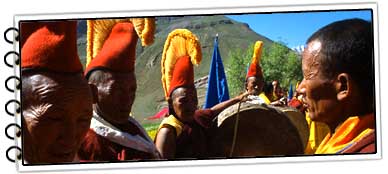
Ladakh Tour - offers tours to Ladakh, LadakhTour Package, Ladakh Cultural Tour, Cycling in Leh & Ladakh.
Ladakh is bounded by world's two mightiest mountain ranges the great Himalayan and the Karakoram, It lies athwart two others The Ladakh and the Zangskar range.
It leaves the first time traveler awestruck by its geographical and cultural difference as they land at Leh. The features of Ladakhi people, their clothes and dialects are similar to Tibetan and Mongoloid then Indian.
It leaves the first time traveler awestruck by its geographical and cultural difference as they land at Leh. The features of Ladakhi people, their clothes and dialects are similar to Tibetan and Mongoloid then Indian.
Ladakh Tour

Home - Ladakh Tourism - Ladakh Fairs & Festivals
Ladakh Fairs & Festivals
The religious philosophy of Buddhism, however, profound and subtle doesn't preclude an immense
 joie-de-vivre among its Ladakhi adhe-rents,a nd even solemn religious enactments are made the occasion for joyous celebration.
Many of the annual festivals of the gompas take place in winter, a relatively idle time for the majority of the people. They take the form of dance-dramas in the gompa courtyards. Lamas, robed in colourful garments and wearing often startlingly frightful masks, performs mimes representing various aspects of the religion such as the progress of the individual soul and its purification or the triumph of good over evil.
Local people flock from near and far to these events, and the spiritual benefits they get are no doubt heightened by their enjoyment of the party atmosphere, with crowds of women and men, the opportunity to make new friendships and renew old ones, the general bustle and sense of occasion. The biggest and most famous of the monastic festivals, frequented by tourists and local alike, is that of Hemis, which falls in late June or the first half of July, and is dedicated to Padmasambhava. Every 12 years, the gompa's greatest treasure, a huge thangka - a religious icon painted or embroidered on cloth - is ritually exhibited.
The next unveiling is due to take place in A.D. 2004. Other monasteries which have summer festivals are Lamayuru (also early July), Phiyang (late July or early August), Tak-thok (about ten days afer Phiyang) and Karsha in Zanskar (11 days after Phiyang). Like Hemis, the Phiyang festival too involves the exhibition of gigantic thangka, though here it is done every year.
Spituk, stok, thikse, chemrey and Matho all have their festivals in winter, between November and March. Likir and Deskit (Nubra )time their festivals to coincide with Dosmoche, the festival of the scapegoat, which is also celebrated with fervour at Leh.
Falling in the second half of February, Dosmoche is one of two New Year festivals, the other being Losar. At Dosmoche, a great wooden mast decorated with streamers and religious emblems is et up outside Leh.
At the appointed time, offerings of storma, ritual figures moulded out of dough, are brought out and ceremonially cast away into the desert, or burnt. These scapegoats carry away with them the evil spirits of the old year, and thus the town is cleansed and made ready to welcome the new year.
Losar falls about the time of the winter solstice, any time between 8th and 30th December. All Ladakhi Buddhists celebrate it by making offerings to the gods, both in gompas and in their domestic shrines.
joie-de-vivre among its Ladakhi adhe-rents,a nd even solemn religious enactments are made the occasion for joyous celebration.
Many of the annual festivals of the gompas take place in winter, a relatively idle time for the majority of the people. They take the form of dance-dramas in the gompa courtyards. Lamas, robed in colourful garments and wearing often startlingly frightful masks, performs mimes representing various aspects of the religion such as the progress of the individual soul and its purification or the triumph of good over evil.
Local people flock from near and far to these events, and the spiritual benefits they get are no doubt heightened by their enjoyment of the party atmosphere, with crowds of women and men, the opportunity to make new friendships and renew old ones, the general bustle and sense of occasion. The biggest and most famous of the monastic festivals, frequented by tourists and local alike, is that of Hemis, which falls in late June or the first half of July, and is dedicated to Padmasambhava. Every 12 years, the gompa's greatest treasure, a huge thangka - a religious icon painted or embroidered on cloth - is ritually exhibited.
The next unveiling is due to take place in A.D. 2004. Other monasteries which have summer festivals are Lamayuru (also early July), Phiyang (late July or early August), Tak-thok (about ten days afer Phiyang) and Karsha in Zanskar (11 days after Phiyang). Like Hemis, the Phiyang festival too involves the exhibition of gigantic thangka, though here it is done every year.
Spituk, stok, thikse, chemrey and Matho all have their festivals in winter, between November and March. Likir and Deskit (Nubra )time their festivals to coincide with Dosmoche, the festival of the scapegoat, which is also celebrated with fervour at Leh.
Falling in the second half of February, Dosmoche is one of two New Year festivals, the other being Losar. At Dosmoche, a great wooden mast decorated with streamers and religious emblems is et up outside Leh.
At the appointed time, offerings of storma, ritual figures moulded out of dough, are brought out and ceremonially cast away into the desert, or burnt. These scapegoats carry away with them the evil spirits of the old year, and thus the town is cleansed and made ready to welcome the new year.
Losar falls about the time of the winter solstice, any time between 8th and 30th December. All Ladakhi Buddhists celebrate it by making offerings to the gods, both in gompas and in their domestic shrines. 